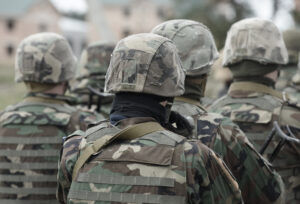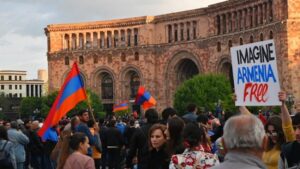Armenia’s Velvet Revolution: Ruben Malayan’s Posters of Protest and Hope
The artist’s works document a monumental step toward democracy in his home country and offer stunning examples of the art of the protest poster. Ruben Malayan’s poster art, fit for a revolution. (Ruben Malayan)
Ruben Malayan’s poster art, fit for a revolution. (Ruben Malayan)
In April and May, the people of Armenia rose up in a series of dramatic anti-government protests in the streets of Yerevan and other cities and towns and peacefully overthrew the government of Serzh Sargsyan. The demonstrations were initially a response to Sargsyan’s attempt to retain power following the transformation of Armenia from a presidential republic to a parliamentary republic. He sought and was briefly elected to the post of prime minister, keeping his hold on the nation’s wealth and power.
During his 10 years in office, corruption was rampant and poverty grew enormously. Many thousands left the country in search of employment, and Armenia’s economic growth benefited those closely linked to Sargsyan’s Republican Party. The protests that led to his ouster were huge and magnificent. Directed by opposition leader Nikol Pashinyan, marches and strikes paralyzed the capital. People of all ages and occupations participated, but young people supplied the most energy and momentum. Pashinyan declared it a Velvet Revolution, reminiscent of the Czech Velvet Revolution in 1989.
In Armenia, there were some arrests and minor violence, but no one was killed, and few injuries were reported. On April 23, Sargsyan resigned, and on May 8, Pashinyan was elected prime minister. Except in Armenian communities in the United States and throughout the diaspora, these dramatic events played out largely off the radar. Americans pay little attention to Armenia and its affairs and usually know little or nothing about its history and culture. The U.S. media paid scant attention to the spring events, and those wanting to follow the drama had to look for more comprehensive and responsible foreign news sources or Armenian-American outlets.
I was fortunate to visit Armenia shortly after the revolution. I found the spirit on the streets extremely optimistic and hopeful. Most people realize, of course, that a simple change in government is only the first step, and probably a minor one at that. The oligarchs who dominate the nation’s wealth and capital resources will not relinquish their power easily. Massive social problems, including unemployment and poverty, lack of access to quality heath care, inadequate housing, domestic violence, homophobia and many others require deeper and longer efforts by political leaders and social organizations.
This Velvet Revolution, perhaps, is the beginning. An exciting feature of the dramatic events was the colorful and dynamic artistic and cultural activity that accompanied the massive protests. One of the most engaging people on the scene was award-winning artist Ruben Malayan, whose posters of protest and hope have added powerfully to the burgeoning body of socially conscious art of the early 21st century.
I attended the exhibition of his posters in Yerevan, Armenia’s capital, and had the opportunity to speak with the veteran artist both about his work and about the massive demonstrations in Republic Square in the city center. Malayan is an exceptionally accomplished visual artist who produced posters daily as the protests increased in intensity. The exhibition was spectacular. His works revealed yet again how the finest political art combines powerful social commentary with excellent technical and formal mastery.
Malayan’s photographs of the protesters provide a dramatic glimpse into one of the most dramatic people’s rebellions since the end of the Soviet Union. Figures 1, 2 and 3 depict mostly youthful demonstrators. Significantly, the last two photographs reveal signs in English. The people knew well that the world was watching and that protest signs in English were more likely to attract the attention of the international media.
Figure 1 shows young Armenians blocking the street, emulating the time-honored tactics of nonviolent protests, including massive disruption and civil disobedience. Figure 2 depicts Armenians at Republic Square with their national flag, with one young woman holding a sign in English proclaiming “Imagine Armenia Free.” Figure 3, which Malayan took at night at Republic Square, is an artful photograph highlighting the defiant word “No,” signifying the collective seriousness of the massive national revolt against the old, corrupt regime.
Malayan’s posters augment the dramatic photographs and elevate the power of the poster as an effective tool of political communication. Figure 4 draws on the artist’s long record as a master of Armenian calligraphy. His decades of study of Armenian manuscripts inform his political art. This is especially present in this poster, which reinforces the “Great Refusal” of “No” through an intricate combination of Armenian calligraphy and the call to Armenian nonviolent revolution in English. The work is stunningly aesthetic, which heightens its political appeal. Observers clearly understand that this is a poster for the ages, an effort that specifically addresses the urgency of the moment yet, like all great political art, also transcends the specific events of April and May.
Figure 5 is more direct: The artist labels the Sargsyan government as a criminal gang, echoing the widespread sentiments of the thousands of protesters. Simple in composition, the poster is effective in communicating its oppositional message, especially to the foreign media covering the protests. Likewise, Figure 6 celebrates the women, men, girls and boys who took to the streets throughout the country. They were—and remain—the Fearless Generation he depicts in the poster. Malayan’s symmetrical dual Armenian/English text highlights the people who left their jobs and their classrooms and took to the streets in a mass uprising for democracy.
The visual complexity of Figure 7 mirrors the many demands of the Armenian revolutionaries. Malayan again uses both Armenian and English to issue a stern warning to the disgraced regime: You Are Done; Traitors of the Armenian Nation; Free Armenia; Nikol, the People’s Choice. The poster also contains the quintessential message of hope, embedded deep within its calligraphic composition: Imagine Free Armenia, the deepest aspiration of millions of Armenian citizens and people throughout the diaspora.
With the revolution successful, and the old, disgraced government thrown from power, much remains to be done. In one of his most visually striking posters (Figure 8), Malayan demands freedom for political prisoners in the new Armenia. It is a beautiful and stunning artwork, with a powerful message of justice.
The issue is whether it will be implemented. The new prime minister has promised to make this a high priority. Pashinyan is himself a former political prisoner, so he deeply understands the human rights issue. He has pledged to establish an independent judicial system in Armenia, and the process of releasing political prisoners has begun.
One of Malayan’s posters raises even deeper issues about change in the new Armenia. Figure 9, “Boycott Oligarch Business,” is a call for major economic action. It recognizes that the economic barons who control the Armenian corporations that the artist identifies in his work are the nation’s real power brokers. His call for a boycott reveals his understanding of the economic realities that have perpetuated the profound imbalance of wealth and power in the country. These oligarchs have been Armenia’s actual rulers since the end of the Soviet era; the previous government has merely been a useful handmaiden to advance their interests at the expense of the majority of the population. A massive consumer boycott would be a valuable step. A more structural change in predatory capitalism would be even better for the nation’s people.
Malayan’s “Revolution Armenia 2018” (Figure 10) is a majestic artistic summary of the Armenian events of April and May. But like all enduring, socially conscious artworks, it has thematic significance beyond its specific focus and origin. The hope of revolution lives among many people in Armenia’s neighboring countries such as Azerbaijan and Turkey, where dictators Ilham Aliyev and Recep Erdogan respectively rule their autocratic nations with iron hands, brutally ignoring human rights and repressing democracy. Clandestine artists in these countries are doubtless creating posters and other works to continue the honorable and sometimes dangerous tradition of visual dissent. Perhaps, too, in Armenia’s other autocratic neighbors, Russia and Iran, other oppositional political artists are at work, at great personal peril.
Ruben Malayan’s posters of protest and hope document a monumental step towards democracy in a remote region of the world. He joins a long and continuing tradition of artists who engage the world critically and who use their talents provocatively to demand a better, more humane future for its citizens.
Your support matters…Independent journalism is under threat and overshadowed by heavily funded mainstream media.
You can help level the playing field. Become a member.
Your tax-deductible contribution keeps us digging beneath the headlines to give you thought-provoking, investigative reporting and analysis that unearths what's really happening- without compromise.
Give today to support our courageous, independent journalists.






You need to be a supporter to comment.
There are currently no responses to this article.
Be the first to respond.